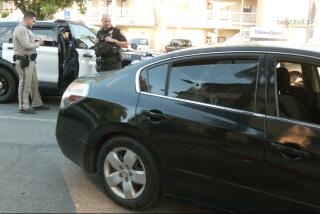Accidents Up Sharply Near Express Lanes
The number of accidents on the heavily traveled Riverside Freeway has increased as much as 124% since the opening of the adjacent toll road--a jump far worse than Caltrans officials have previously disclosed, according to internal agency documents obtained by The Times.
The documents show those numbers were given to top Caltrans officials on at least three occasions last year, and that safety engineers said plans to add three new lanes to the freeway could cut the number of accidents by a third.
Yet Caltrans officials agreed in October to shelve plans for the extra lanes to settle a lawsuit with the private 91 Express Lanes operator, who accused the agency of trying to siphon off its business.
Jim Drago, a Caltrans spokesman, said the agency settled the lawsuit âbased on the facts--that in our judgment our chances of prevailing were not very good.â
He added that the agencyâs own accident statistics were contradicted by other Caltransâ data, which showed that the accident rates were not out of line with those of other freeways.
However, the documents released to The Times Friday--which contain thousands of pages of accident data--show otherwise, pointing to a pattern of problems ever since the toll lanes were built.
The problems are most serious when motorists enter the private toll lanes by merging into the median of the Riverside Freeway in a relatively short distance--creating a dangerous weaving problem on one of the most heavily congested roads in Southern California.
Caltrans engineers offered this solution: add one eastbound lane and two westbound lanes spanning the Riverside/Orange County border, creating more room for motorists to merge.
In January, February and again in May of last year, Caltrans safety experts outlined the troubling pattern of accidents dating back to the opening in late 1995 of the 10-mile private toll road, according to the internal documents.
The accidents were highest for morning commuters on the heavily congested road traveling from their homes in the Inland Empire to jobs in Orange and Los Angeles counties.
The analysis of crash data found the number of injury accidents had increased 124% near the westbound entrance to the toll facility in the 2 1/2 years after it opened. In the three years prior to the toll lanes opening, there were 34 accidents compared to 76 on that same stretch after the lanes opened.
The problems werenât limited to the tollway entrance. All along the section where Caltrans wanted to add lanes, accidents were up--598 in the three years prior to the toll lanes opening compared to 1,018 in the 2 1/2 years after the opening, a 70% increase.
âOur analyses indicates that operational deficiencies are the primary cause of the high accident rate in the project area and are considered to be a contributing factor with respect to approximately 50% of the accidents,â one engineer in Orange County wrote in May 1999. âOf particular concern is the limited two-sided weaving distance . . . which is causing, or contributing to, a large number of accidents.â
Fixing those weaving problems by adding more lanes, the engineer wrote, could cut the accident rate by at least one-third and safety benefits could total $45.7 million a year.
Still, Caltrans Director Jose Medina agreed in October to postpone for decades plans to add lanes near the toll facility. In a legal agreement that settled a $100-million lawsuit filed by the private operators of the toll lanes to block the work, Medina agreed to wait at least six years to do even minor improvements to the road.
Medina has declined repeated requests for interviews and it is unclear if he was aware of the safety analysis before making his decision, although memos regarding the situation are addressed to his top advisors.
Medinaâs decision to back off the roadwork has come under fire by high-ranking state and local officials who have charged that Caltrans put the profit of a private company over its mandate to protect the traveling public. Medina and other top Caltrans officials will be questioned at a special legislative hearing scheduled for Feb. 1 in Sacramento.
The Times made a verbal request to see all documents relating to the lawsuit settlement. The documents were also released to lawmakers in preparation for the hearing.
A âseriousâ safety situation on the Riverside Freeway was first described by Caltrans officials in a December 1997 report that outlined plans to add lanes at the Riverside/Orange border. The Times first revealed those detailed safety concerns last month.
But three later reports issued in 1999 and other internal documents portray a more dire situation on the freeway. The situation is particularly bad between the Eastern Toll Road in Orange County and Route 71 in Riverside County, where as many as 4,200 cars an hour cross paths. Officials warned the situation would only get worse.
âThis is a relatively new situation that developed following the opening of both the Route 91 and Route 241 Toll Facilities,â one report says. Engineers express a high level of concern about startling increases in accidents when the road is dark or wet and urge further research be done to determine what role, if any, the toll roads played in the increase.
Local officials believed improvements were critically needed on the heavily congested link, securing $30.6 million to do the work, which was originally scheduled to begin late this year and be completed in 2002.
But it wasnât that simple.
A restrictive contract the state had granted to the 91 Express Lanes prohibited anything but safety improvements to state highways that competed with business on the toll lanes. The toll lane operator, California Private Transportation Co., immediately protested, saying the work would siphon cars from their toll lanes.
The work, they said, would harm their business, cutting revenue on the road by as much as 50%. Such a loss would have made the road a risky investment, thwarting the private companyâs plans to refinance the road, according to letters written by toll lane officials to Caltrans.
The toll lanes operator dismissed as âlaughableâ Caltrans accident statistics used to bolster a safety justification for the roadwork, according to a letter from its attorney to a Caltrans lawyer written in November 1998.
âThe accident statistics Caltrans cites hardly [show] a severe safety situation; at most, they indicate an excess . . . of fender bender accidents,â wrote Matthew Johnson, an attorney for the toll lanes group.
âBut even if Caltransâ statistics [showed] the existence of a ârealâ safety issue,â Johnson wrote, âthey would not justify construction.â
It was the exact scenario some lawmakers had warned could take place, when they protested passage of the 1989 law that made private road building possible in the state.
Over the next two years, local Caltrans officials in Orange and Riverside counties pushed the project forward while toll lane representatives appealed to Caltrans headquarters to back off. In March 1999, the toll lanes group filed its $100-million suit against Caltrans for violating the franchise agreement.
Caltrans sources familiar with the lawsuit say some officials believed they were on âshaky legal ground.â
And internal documents show some hesitation within Caltrans about how traffic engineers calculated the projectâs safety benefits. A confidential memo written in June, while Caltrans was still actively defending the road improvements, showed concern that the earlier report might have been âdistortingâ the safety benefits of the road improvements.
In that same memo, however, an unidentified traffic operations engineer wrote that the lanes were still needed.
âThis is not to say that auxiliary lanes cannot reduce the number of accidents,â the engineer wrote. âIt most likely will reduce the congestion type accidents--rear-end and sideswipe accidents are the most common in congested highway locations.â
Staff writer Ray F. Herndon contributed to this report.
(BEGIN TEXT OF INFOBOX / INFOGRAPHIC)
Safety Improvements Scrapped
Top Caltrans officials delayed plans to add auxiliary lanes to the Riverside Freeway, although engineers said the lanes could reduce accidents. The agencyâs own crash data found injury and fatal accidents had increased as much as 124% near the westbound entrance since the toll facility had opened.
*
Source: Caltrans
More to Read
Sign up for Essential California
The most important California stories and recommendations in your inbox every morning.
You may occasionally receive promotional content from the Los Angeles Times.












